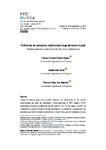Mostrar o rexistro simple do ítem
Preferencias de celebración matrimonial: el auge del evento nupcial
| dc.contributor.author | Mamani, Ángela | |
| dc.contributor.author | Andrés Arko, Boris | |
| dc.contributor.author | Fuentes Cuiñas, Ana Alejandra | |
| dc.date.accessioned | 2019-07-10T11:42:18Z | |
| dc.date.available | 2019-07-10T11:42:18Z | |
| dc.date.issued | 2019 | |
| dc.identifier.citation | Mamani Condori, N. A., Andrés Arko, B., & Fuentes Cuiñas, A. A. (2019). Preferencias de celebración matrimonial: el auge del evento nupcial. Redmarka. Revista De Marketing Aplicado, 23(1), 57-74. https://doi.org/10.17979/redma.2019.23.1.5455 | es_ES |
| dc.identifier.issn | 1852-2300 | |
| dc.identifier.uri | http://hdl.handle.net/2183/23488 | |
| dc.description.abstract | [Resumen] Desde los últimos años, se ha podido observar una disminución en las uniones matrimoniales (en tasas de nupcialidad y cifras absolutas). El 2017 registro 10.525 matrimonios inscriptos, a diferencia del año anterior con 11.630, según Dirección de Estadísticas y Censos. El objetivo de esta investigación fue identificar y caracterizar a los individuos que tienen la intención de formar un matrimonio, así como realizar procesos, servicios o eventos de celebración nupcial. Se realizó muestreo no aleatorio de 733 casos. La población objeto de estudio se compuso de habitantes de CABA y Gran Buenos Aires, ambos géneros, edades entre 18 y 65 años. Se utilizaron técnicas de análisis multivariado: Análisis Chi cuadrado y de correlaciones bivariadas. Los resultados indican individuos femeninos, jóvenes (18-30) y nivel educativo universitario en curso o superior como el grupo de mayor tendencia a la realización de eventos nupciales. Además, se observa mayor inclinación a viajar como método de celebración. | es_ES |
| dc.description.abstract | [Abstract] In recent years, marital unions have decreased significantly (in terms of both nuptiality rates and absolute figures). The year 2017 registered 10,525 marriages, while during the previous year this amount ascended to 11,630 cases, according to the Statistics and Census Bureau. The objective of this research was to identify and characterize the individuals who intend to marriage, as well as perform processes, services or events of nuptial celebration. Non-random sampling of 733 cases was performed. The population studied was composed of inhabitants of CABA and Greater Buenos Aires, both genders, ages between 18 and 65. Multivariate analysis techniques were used: Chi square analysis and bivariate correlations. The results indicate females, young people (18-30) and individuals of university education level (in progress or higher) as the groups with the highest tendencies to carry out nuptial events. In addition, there is a greater inclination to travel as a method of celebration. | es_ES |
| dc.language.iso | spa | es_ES |
| dc.publisher | Universidade da Coruña | es_ES |
| dc.relation.uri | https://doi.org/10.17979/redma.2019.23.1.5455 | es_ES |
| dc.rights | Atribución-CompartirIgual 4.0 España | es_ES |
| dc.rights.uri | http://creativecommons.org/licenses/by-sa/4.0/es/ | * |
| dc.subject | Matrimonio | es_ES |
| dc.subject | Evento nupcial | es_ES |
| dc.subject | Viaje | es_ES |
| dc.subject | Celebración | es_ES |
| dc.subject | Tendencia | es_ES |
| dc.subject | Marriage | es_ES |
| dc.subject | Wedding event | es_ES |
| dc.subject | Trip | es_ES |
| dc.subject | Celebration | es_ES |
| dc.subject | Trend | es_ES |
| dc.title | Preferencias de celebración matrimonial: el auge del evento nupcial | es_ES |
| dc.title.alternative | Wedding celebration preferences: the rise of the wedding event | es_ES |
| dc.type | info:eu-repo/semantics/article | es_ES |
| dc.rights.access | info:eu-repo/semantics/openAccess | es_ES |
| UDC.journalTitle | Redmarka: revista académica de marketing aplicado | es_ES |
| UDC.volume | 23 | es_ES |
| UDC.issue | 1 | es_ES |
| UDC.startPage | 57 | es_ES |
| UDC.endPage | 74 | es_ES |






